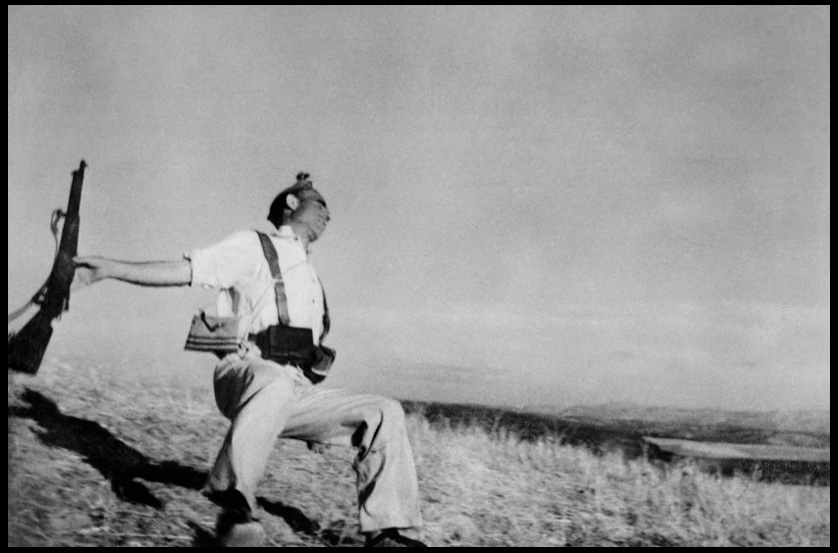For this post I will be analyzing how a photo of my choice by a photographer can be interpreted and the story behind it that may be carried. The photographer I have chosen is called Robert Capa, a Hungarian war photographer, considered one of the greatest in history, here I have selected his famous ‘Death of a Loyalist Soldier’, 1936, which depicts the instant death that this loyalist has been captured through in mid shot. Here I will be looking at four factors that create such an impact when reviewing the picture; contextual, conceptual, visual and technical. Contextual: Taken during the beginning of the Spanish Civil War, showing the moment of a bullet’s impact on a loyalist soldier, Capa’s photograph has become the emblem for the medium’s unrivaled capacity to depict sudden death. The style of photojournalism became the mark that defined Capa’s work from there on, joining the company Magnum Photos in the late 1940s. The photo itself appear to capture a Republican soldier at the moment of death, the soldier is seen collapsing backward after being picked off from a distance by a sniper. The pictured solider is dressed in civilian clothing but wears a cartridge belt, and following its publication was acclaimed as one of the greatest photos ever taken. However since the 1970s there has been significant doubts about its authenticity due to its location, the identity of its subjects, and the discovery of staged photographs taken at the same time and place.
Contextual: Taken during the beginning of the Spanish Civil War, showing the moment of a bullet’s impact on a loyalist soldier, Capa’s photograph has become the emblem for the medium’s unrivaled capacity to depict sudden death. The style of photojournalism became the mark that defined Capa’s work from there on, joining the company Magnum Photos in the late 1940s. The photo itself appear to capture a Republican soldier at the moment of death, the soldier is seen collapsing backward after being picked off from a distance by a sniper. The pictured solider is dressed in civilian clothing but wears a cartridge belt, and following its publication was acclaimed as one of the greatest photos ever taken. However since the 1970s there has been significant doubts about its authenticity due to its location, the identity of its subjects, and the discovery of staged photographs taken at the same time and place.
Conceptual: The idea behind the image was to capture one of the most shocking moments in war, death. Although it was supposedly an accident, the image itself was published because of its insight into the impact of war, and how one moment can lead to another resulting in tragedy. When taken the photographer wanted to capture life on the front line, and life between skirmishes, attempting to depict life in such an isolated region of the country.
Technical: The image itself uses a higher shutter speed to capture the motion of the solider without blurring either the subject and landscape, by doing this the result is crisper without any eye-sores created by faults. Within this image the contrast seems to have been lowered so that only the more dominantly dark objects are defined (such as shadows, gun, hair and dark grass), this leaves the rest of the photo as more bland and faded due to it only consisting of different shades of white, whilst creating a stark outline for the main focus of the picture, the soldier. The black and white result of the camera used produces a more sinister tone surrounding his death due to it being devoid of any other colours, this to me adds context to the image as it reduces your perspective on the story being portrayed, instead giving only the option of two viewpoints.
Visual: Visually the pieces incorporates an executioner, stark backdrop and dramatic nocturnal lighting. By doing so, this for the viewer zeroes on the instantaneous death received by the soldier which will be forever anticipated in the photograph. The image itself seems to resemble an equally famous picture of the civil war in Spain named “The Third of May, 1808” by Francisco Goya in 1814, this provides a narrative element for Capa’s image due to there being a story behind the position and landscape it was taken in. Because of the piece perfectly evokes both discrete moment and an epoch, where one encounters a distillation of the Fascist violence, and the brutally extinguished Republican sense of hope for a new, free egalitarian society, ultimately defining the Spanish Civil War.
